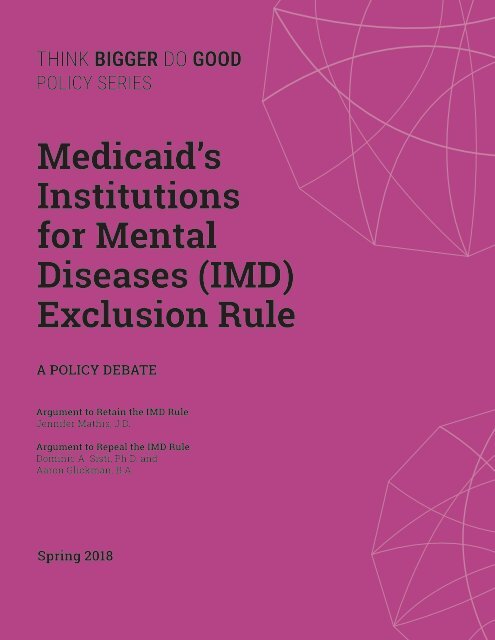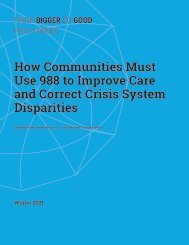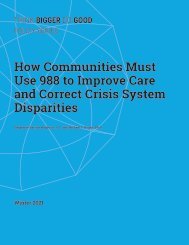Scattergood_IMD_Web
You also want an ePaper? Increase the reach of your titles
YUMPU automatically turns print PDFs into web optimized ePapers that Google loves.
THINK BIGGER DO GOOD<br />
POLICY SERIES<br />
Medicaid’s<br />
Institutions<br />
for Mental<br />
Diseases (<strong>IMD</strong>)<br />
Exclusion Rule<br />
A POLICY DEBATE<br />
Argument to Retain the <strong>IMD</strong> Rule<br />
Jennifer Mathis, J.D.<br />
Argument to Repeal the <strong>IMD</strong> Rule<br />
Dominic A. Sisti, Ph.D. and<br />
Aaron Glickman, B.A.<br />
Spring 2018
Behavioral Health and the Individual Health Insurance Market
Dear Reader,<br />
Now is a time of change in health and human services policy. Many of the changes could have profound<br />
implications for behavioral health. This paper is one in a series of papers proposing solution-oriented<br />
behavioral health policies.<br />
The past decade has been a time of steady advances in behavioral health policy. For example, we have<br />
met many of the objectives related to expanding health insurance coverage for people with behavioral<br />
health conditions. Coverage is now expected to be on a par with that available to individuals with any<br />
other health conditions, although parity implementation has encountered roadblocks. Coverage of evidencebased<br />
treatments has expanded with insurance, but not all of these services are covered by traditional<br />
insurance, necessitating other sources of funding, such as from block grants.<br />
Much has improved; much remains to be accomplished.<br />
As funders, The Thomas <strong>Scattergood</strong> Behavioral Health Foundation and Peg’s Foundation believe that<br />
now more than ever philanthropic support in the area of policy is critical to improving health outcomes<br />
for all. We ask that you share this paper and the others in the series with your programmatic partners,<br />
local, state, and federal decision makers, advocacy organizations, and voters.<br />
We believe that these papers analyze important issues in behavioral health policy, can inform policymaking,<br />
and improve health outcomes. In the back of the paper, there are suggested ways of how one<br />
can use the paper to further share these solution-oriented ideas and advocate for change. We hope these<br />
papers help to extend progress and avoid losing ground at a time of change in policy.<br />
Sincerely,<br />
Joseph Pyle, M.A.<br />
President<br />
<strong>Scattergood</strong> Foundation<br />
Founding Partner of Series<br />
Rick Kellar, M.B.A.<br />
President<br />
Peg’s Foundation<br />
Founding Partner of Series<br />
Howard Goldman, M.D., P.h.D.<br />
Series Editor
We would like to acknowledge the following individuals for their participation in<br />
the convening and the ongoing process that led to the conceptualization of the<br />
papers in this series.<br />
Colleen Barry, Ph.D., M.P.P.<br />
Bloomberg School of Public Health at<br />
John Hopkins University<br />
Cynthia Baum-Baicker, Ph.D.<br />
Thomas <strong>Scattergood</strong> Behavioral<br />
Health Foundation<br />
Lisa Dixon, M.D., M.P.H.<br />
Columbia University College of<br />
Physicians and Surgeons,<br />
New York State Psychiatric Institute<br />
Arthur Evans, Ph.D.<br />
American Psychological Association<br />
Alyson Ferguson, M.P.H.<br />
Thomas <strong>Scattergood</strong> Behavioral<br />
Health Foundation<br />
Richard Frank, Ph.D.<br />
Harvard Medical School<br />
Rachel Garfield, Ph.D.<br />
Kaiser Family Foundation<br />
Howard Goldman, M.D., Ph.D.<br />
University of Maryland School of Medicine<br />
Pamela Greenberg, M.P.P.<br />
Association for Behavioral Health<br />
and Wellness<br />
Kimberly Hoagwood, Ph.D.<br />
New York University School of Medicine<br />
Mike Hogan, Ph.D.<br />
Case Western Reserve University<br />
School of Medicine<br />
Chuck Ingoglia, M.S.W.<br />
National Council for Behavioral Health<br />
Sarah Jones, M.D. Candidate<br />
Thomas <strong>Scattergood</strong> Behavioral<br />
Health Foundation<br />
Rick Kellar, M.B.A.<br />
Margaret Clark Morgan Foundation<br />
Jennifer Mathis, J.D.<br />
Bazelon Center for Mental Health Law<br />
Amanda Mauri, M.P.H.<br />
Thomas <strong>Scattergood</strong> Behavioral<br />
Health Foundation<br />
Brian McGregor, Ph.D.<br />
Satcher Health Leadership Institute at<br />
Morehouse School of Medicine<br />
Mark Munetz, M.D.<br />
Northeast Ohio Medical University<br />
Sandra Newman, Ph.D.<br />
John Hopkins Bloomberg School of<br />
Public Health<br />
Joe Pyle, M.A.<br />
Thomas <strong>Scattergood</strong> Behavioral<br />
Health Foundation<br />
Lloyd Sederer, M.D.<br />
New York State Office of Mental Health,<br />
Mailman School of Public Health at<br />
Columbia University<br />
Andrew Sperling, J.D.<br />
National Alliance for Mental Illness<br />
Hyong Un, M.D.<br />
Aetna<br />
Kate Williams, J.D.<br />
Thomas <strong>Scattergood</strong> Behavioral<br />
Health Foundation<br />
Glenda Wrenn, M.D., M.S.H.P.<br />
Satcher Health Leadership Institute at<br />
Morehouse School of Medicine<br />
Julia Zur, Ph.D.<br />
Kaiser Family Foundation<br />
Medicaid’s Institutions for Mental Diseases (<strong>IMD</strong>) Exclusion Rule: A Policy Debate 4
Titles in the Paper Series<br />
Editors Howard Goldman, M.D., Ph.D. and Constance Gartner, M.S.W.<br />
America’s Opioid Epidemic Lloyd Sederer, MD<br />
Behavioral Health and the Individual Health Insurance Market: Preserving Key<br />
Elements of Reform Richard Frank, Ph.D. and Sherry Glied, Ph.D., M.A.<br />
Coordinated Specialty Care for First-Episode Psychosis: An Example of Financing<br />
for Specialty Programs Lisa Dixon, M.D., M.P.H.<br />
Fentanyl and the Evolving Opioid Epidemic: What Strategies Should Policymakers<br />
Consider? Colleen Barry, Ph.D., M.P.P.<br />
Improving Outcomes for People with Serious Mental Illness and Co-Occurring<br />
Substance Use Disorders in Contact with the Criminal Justice System Glenda<br />
Wrenn, M.D., M.S.H.P., Brian McGregor, Ph.D., and Mark Munetz, M.D.<br />
Medicaid’s Institutions for Mental Diseases (<strong>IMD</strong>) Exclusion Rule: A Policy Debate<br />
Jennifer Mathis, J.D., Dominic A. Sisti, Ph.D. and Aaron Glickman, B.A.<br />
Suicide Is a Significant Health Problem Mike Hogan, Ph.D.<br />
The Current Medicaid Policy Debate and Implications for Behavioral Healthcare in<br />
the United States Rachel Garfield, Ph.D., M.H.S. and Julia Zur, Ph.D.<br />
Find the papers online at http://bit.ly/2noiOds
Medicaid’s Institutions for Mental Diseases (<strong>IMD</strong>) Exclusion Rule: A Policy Debate 6
Medicaid’s<br />
Institutions<br />
for Mental<br />
Diseases (<strong>IMD</strong>)<br />
Exclusion Rule<br />
A POLICY DEBATE<br />
Argument to Retain the <strong>IMD</strong> Rule<br />
Jennifer Mathis, J.D.<br />
Deputy Legal Director and Director of Policy and Legal Advocacy<br />
Judge David L. Bazelon Center for Mental Health Law<br />
Argument to Repeal the <strong>IMD</strong> Rule<br />
Dominic A. Sisti, Ph.D.<br />
Director, <strong>Scattergood</strong> Program for Applied Ethics in Behavioral Health Care<br />
Department of Medical Ethics and Health Policy<br />
Perelman School of Medicine, University of Pennsylvania<br />
Aaron Glickman, B.A.<br />
Policy Analyst, <strong>Scattergood</strong> Program for Applied Ethics in Behavioral Health Care<br />
Department of Medical Ethics and Health Policy<br />
Perelman School of Medicine, University of Pennsylvania
The <strong>IMD</strong> exclusion rule, which has been in place since<br />
the beginning of the Medicaid program in 1965, bars<br />
the use of federal Medicaid funds to finance services<br />
for individuals ages 22 to 64 residing in “institutions<br />
for mental diseases” or <strong>IMD</strong>s—hospitals, nursing<br />
homes, or other institutions with more than 16 beds<br />
that are primarily engaged in providing diagnosis,<br />
treatment, or care of persons with “mental diseases”<br />
other than dementia or intellectual disabilities.<br />
Medicaid’s Institutions for Mental Diseases (<strong>IMD</strong>) Exclusion Rule: A Policy Debate 8
Argument<br />
to Retain<br />
the <strong>IMD</strong> Rule<br />
Introduction<br />
Recent years have brought increasing calls for the repeal of Medicaid’s long-standing<br />
<strong>IMD</strong> exclusion rule, accompanied by the refrain that deinstitutionalization has<br />
“gone too far” and by the contention that dramatic downsizing of psychiatric hospital<br />
capacity over the past half century reflects a crisis. Although our mental health<br />
systems are in crisis, neither the <strong>IMD</strong> rule nor insufficient hospital beds are the<br />
primary problem. The primary problem is the failure to implement an effective system<br />
of intensive community-based services, which have been shown to prevent or<br />
shorten hospitalizations. Repealing the <strong>IMD</strong> rule would do little to alleviate the true<br />
crises in our public mental health systems and would likely deepen those crises.
1 The <strong>IMD</strong> Rule Has<br />
Been an Important<br />
Driver of the Shift<br />
Toward Community<br />
Services<br />
The <strong>IMD</strong> exclusion rule, which has been in place since the beginning of the Medicaid<br />
program in 1965, bars the use of federal Medicaid funds to finance services for<br />
individuals ages 22 to 64 residing in “institutions for mental diseases” or <strong>IMD</strong>s—<br />
hospitals, nursing homes, or other institutions with more than 16 beds that are<br />
primarily engaged in providing diagnosis, treatment, or care of persons with “mental<br />
diseases” other than dementia or intellectual disabilities (1). Congress’s adoption<br />
of the rule reflected its view that serving individuals in mental institutions was<br />
a state responsibility. Lawmakers did not want federal payments to replace state<br />
financial commitments i .<br />
The rule’s enactment, coming two years after Congress passed the Community<br />
Mental Health Centers Act, also reflected congressional intent to promote a shift<br />
toward community-based services. In adopting the <strong>IMD</strong> rule, Congress explained<br />
that community mental health centers were “being particularly encouraged by<br />
Federal help under the Community Mental Health Centers Act of 1963,” that “often<br />
the care in [psychiatric hospitals] is purely custodial,” and that Medicaid would<br />
provide for “the development in the State of alternative methods of care and requires<br />
that the maximum use be made of the existing resources in the community which<br />
offer ways of caring for the mentally ill who are not in hospitals” (1).<br />
i. “The committee believes that responsibility for the treatment of persons in mental hospitals—whether or not they be assistance<br />
recipients—is that of the mental health agency of the State” (1). When Congress adopted the <strong>IMD</strong> rule, state psychiatric<br />
hospitals predominated and states generally did not pay for care in private psychiatric hospitals. Nevertheless, Congress<br />
also made the rule applicable to freestanding private psychiatric hospitals, likely reflecting the concerns about long-term<br />
institutional care described below and to encourage the use of community services and acute-care general hospitals instead.<br />
Medicaid’s Institutions for Mental Diseases (<strong>IMD</strong>) Exclusion Rule: A Policy Debate 10
Because states can draw down federal Medicaid reimbursement for community<br />
services but generally not for care in psychiatric hospitals, the <strong>IMD</strong> rule has been<br />
an important driver of state systems shifting toward community services. That<br />
has been good policy.<br />
Complaints about the loss of psychiatric hospital beds often give short shrift to the<br />
important reasons why public systems deliberately reduced investment in hospital<br />
capacity and shifted resources to community capacity: to promote better and less<br />
costly treatment in the community and in particular new approaches and improved<br />
services that enable even people with challenging conditions to regain their independence,<br />
dignity, and autonomy. This shift reflects a dramatic, albeit insufficient,<br />
reinvestment in more modern, effective community services, which has resulted<br />
in thousands of people once warehoused in state hospitals thriving in community<br />
settings. Furthermore, Medicaid does cover inpatient services in general hospitals,<br />
including those provided in specialized psychiatric units. In contrast to 1963, when<br />
state systems provided state hospital services and little else, ii the vast majority of<br />
public service system dollars now support individuals in community settings (2). iii<br />
That is a benefit, not a loss. And although much of the savings from hospital closures<br />
was never reinvested in community services, that failure suggests the remedy of<br />
making good on the promise to expand community services, not rebuilding hospitals.<br />
ii. “Until the passage of the Community Mental Health Act in 1963, community mental health programs had been initiated in a few<br />
states, but in most states, ‘SMHA’ meant ‘state hospital.’ The vast majority of state expenditures and services for individuals with<br />
mental illness was devoted to state psychiatric hospitals” (2).<br />
iii. Between FY 1981 and FY 2015, state hospital expenditures increased 159% while community expenditures increased 1,528% (2).
2 Inpatient Bed Shortages<br />
Reflect Gaps in<br />
Community Services<br />
As the state mental health program directors themselves have emphasized, pressure<br />
to increase psychiatric inpatient capacity “often actually stems from an underfunded<br />
community mental health system, exemplified by emergency department overcrowding<br />
and boarding, visible chronic homelessness, increased police encounters<br />
and jail census, stigma, or a high profile-incident” (3).<br />
Accordingly, “When determining psychiatric inpatient capacity, system leaders should<br />
first assess the capacity of evidence-based community programs and services to reduce<br />
the need for inpatient care” (3). Community services such as assertive community<br />
treatment, crisis services, supportive housing, and other services have proven<br />
successful in reducing inpatient admissions and bed-days, as well as incarceration<br />
in jails and prisons (3). Yet calls for more psychiatric hospital beds almost never take<br />
into account what additional community capacity is needed and how much reduction<br />
in inpatient beds—or arrests and incarceration—could be expected if that capacity<br />
were developed. Dr. Jess Jamieson, former Director of State Hospitals in Washington<br />
State, observed (4): “When I was running the State hospitals in Washington, we were<br />
right in the middle of this controversy…boarding patients in the ERs waiting for a<br />
bed. My hospitals were full, so the prevailing attitude was we needed more beds.<br />
This is not the solution! What I needed was a stronger community-based system<br />
to divert patients from inpatient hospitalizations and the community resources to<br />
discharge my patients who were ready for community placement, thus opening up<br />
a bed for those patients who needed hospitalization. The problem was the community<br />
system was under funded and lacked resources.”<br />
Medicaid’s Institutions for Mental Diseases (<strong>IMD</strong>) Exclusion Rule: A Policy Debate 12
Community services such as assertive community<br />
treatment, crisis services, supportive housing,<br />
and other services have proven successful in reducing<br />
inpatient admissions and bed-days, as well as<br />
incarceration in jails and prisons.<br />
Not only is the expansion of community services frequently overlooked as a solution,<br />
so too is the fact that the number of private psychiatric hospital beds has actually<br />
increased in recent decades (2), iv and it is these beds, not state hospital beds, that are<br />
especially suited for crisis care. Moreover, the significant decreases in state hospital<br />
beds occurred years ago. As the state mental health program directors observed:<br />
“The shortage of bed capacity is often attributed to the closure of state psychiatric<br />
hospitals. But…most of the state psychiatric hospital bed capacity that has been closed<br />
was actually closed decades ago, with the rate of downsizing drastically slowed in<br />
recent years” (2).<br />
iv. Between 1982 and 2010, while state and county psychiatric hospital beds decreased by 69%, all other mental health inpatient<br />
and residential beds increased by 14%. Between 1983 and 2014, state and county psychiatric hospital beds decreased 66%, from<br />
117,084 to 39,907, while private psychiatric hospital beds increased 77%, from 16,079 to 28,461. Notably, much of the decrease in state<br />
hospital capacity was occasioned not only by the increased reliance on community services but also by a significant decrease in<br />
their use to serve individuals with “organic brain syndrome” or intellectual and developmental disabilities, who occupied nearly<br />
40% of state hospital beds in 1970 but now are largely served in other settings (2).
3 Federal Reimbursement<br />
for <strong>IMD</strong>s Is Not a<br />
Guarantee of Increased<br />
Access to Care<br />
IN FACT, IT WOULD LIKELY DECREASE ACCESS<br />
Allowing federal reimbursement to states for providing inpatient psychiatric care<br />
does not guarantee expansion of such care. Repeal of the <strong>IMD</strong> rule would make each<br />
hospital bed less expensive for the state to operate or rely on but would not require<br />
an expansion of this form of care. Indeed, the long history of states’ underinvestment<br />
in mental health services strongly suggests that states would not use the savings<br />
they realize from repeal of the <strong>IMD</strong> rule to expand mental health services.<br />
In fact, a large federal demonstration project recently examined whether allowing<br />
federal reimbursement for private <strong>IMD</strong> beds for adults ages 21 to 64 would improve<br />
access to inpatient care. The demonstration project, authorized by the Affordable Care<br />
Act, required the Centers for Medicare and Medicaid Services to assess the effects<br />
of providing Medicaid reimbursements to private psychiatric hospitals for individuals<br />
ages 21–64. The Medicaid Emergency Psychiatric Services Demonstration Evaluation<br />
ran from 2012 through 2015. Through this project, 11 states and the District of Columbia<br />
received federal Medicaid matching funds for inpatient treatment in participating<br />
private <strong>IMD</strong>s for beneficiaries with psychiatric emergency medical conditions, which<br />
were defined as being suicidal, homicidal, or dangerous to oneself or others. As<br />
mandated by the ACA, the evaluation addressed the following areas: Medicaid inpatient<br />
access, length of stay, and emergency room visits; discharge planning by participating<br />
hospitals; impact on costs of the full range of mental health services, including inpatient,<br />
emergency, and ambulatory care; and the percentage of individuals admitted to<br />
participating <strong>IMD</strong>s as a result of the demonstration, compared with those admitted<br />
to the same facilities through other means.<br />
Medicaid’s Institutions for Mental Diseases (<strong>IMD</strong>) Exclusion Rule: A Policy Debate 14
The final evaluation report indicated that federal reimbursement<br />
for private <strong>IMD</strong> beds did not increase access to inpatient care<br />
for adults ages 21–64 (5). The evaluation found no increase in the<br />
number of inpatient admissions or the length of stays in <strong>IMD</strong>s,<br />
no decrease in the number of emergency room visits or the length<br />
of emergency department boarding, and no decrease in the<br />
number of admissions to or lengths of stay in non-psychiatric<br />
units in general hospitals (5). The report did note, however,<br />
that “one of the most consistent findings from our interviews<br />
was the existence of significant shortages of communitybased<br />
outpatient services. Both beneficiaries and facility staff<br />
almost universally reported difficulties in obtaining needed<br />
aftercare services from community providers.”<br />
Whether repeal of the <strong>IMD</strong> rule would expand psychiatric<br />
hospital services or not, the enormous sum that it would cost<br />
the federal government would almost certainly bring similarsized<br />
federal cuts to other parts of the Medicaid program, likely<br />
resulting in reduced funding for community services and<br />
generating new pressures on inpatient capacity. It is naïve to<br />
assume that the $40 billion to $60 billion federal price tag<br />
estimated for repeal of the <strong>IMD</strong> rule (6) would be adopted by any<br />
Congress without offsetting cuts, particularly in light of<br />
pay-go rules—but especially now, with federal commitment<br />
to the Medicaid program at a historic low, as evidenced by<br />
the near passage of legislation that would have cut the program<br />
to the bone.
4 The <strong>IMD</strong> Rule<br />
Does Not Promote<br />
Discrimination―<br />
It Prevents It<br />
Arguments that the <strong>IMD</strong> rule discriminates against people with mental illness miss<br />
the mark and ignore the discrimination that comes from needless institutionalization.<br />
The <strong>IMD</strong> rule does not bar Medicaid from covering inpatient psychiatric hospital<br />
services. Medicaid covers these services and always has, if they are provided in a<br />
general hospital setting rather than in a freestanding psychiatric hospital. Congress’s<br />
decision to provide Medicaid coverage for inpatient psychiatric care in a general<br />
hospital setting, where people without mental illnesses also receive care, rather than<br />
in a segregated setting does not amount to discrimination. If anything, the opposite<br />
is true.<br />
Moreover, Congress’s choice promotes the integration of mental health care and<br />
medical care, the importance of which has been widely recognized. People with<br />
serious mental illnesses have high rates of diabetes, heart disease, cancer, stroke,<br />
and pulmonary disease and tend to die at a much earlier age than the general<br />
population. These physical health problems may be exacerbated by obesity, smoking,<br />
substance use, and side effects of psychiatric medications. General hospitals with<br />
psychiatric units are well positioned not only to address a mental health crisis<br />
but also to treat the “whole person,” including co-occurring and interrelated physical<br />
health issues.<br />
Not only does the <strong>IMD</strong> rule not discriminate, it helps prevent discrimination by<br />
promoting compliance with the Americans with Disabilities Act (ADA). The ADA’s<br />
“integration mandate” and the 1999 Olmstead decision prohibit institutionalization<br />
of people with disabilities who could be served in community settings if providing<br />
community services can be reasonably accommodated. Although the worst abuses<br />
of psychiatric institutions may be in the past, v institutionalization of individuals<br />
v. Although the types of abuses that occurred in the Willowbrook State School on Staten Island or Byberry (Philadelphia State<br />
Hospital) are not common today, abuse, neglect, and poor conditions in psychiatric hospitals are hardly a relic of the past, as<br />
evidenced by numerous Justice Department findings and enforcement actions and other examples (https://bit.ly/1WiyQ5b).<br />
Medicaid’s Institutions for Mental Diseases (<strong>IMD</strong>) Exclusion Rule: A Policy Debate 16
who could be served in community settings is itself harmful, regardless of whether<br />
abuse occurs. As the Supreme Court observed in its Olmstead decision, needless<br />
institutionalization is a form of discrimination because “institutional placement of<br />
persons who can handle and benefit from community settings perpetuates unwarranted<br />
assumptions that persons so isolated are incapable or unworthy of participating in<br />
community life…and institutional confinement severely diminishes the everyday life<br />
activities of individuals” (7).<br />
Enforcement by the U.S. Department of Justice and private plaintiffs has resulted in<br />
Olmstead settlement agreements across the country that require states to offer sufficient<br />
assertive community treatment, supported housing, mobile crisis services, supported<br />
employment, and peer support services to avoid needless institutionalization in state<br />
psychiatric hospitals, psychiatric nursing facilities, adult homes, and other institutional<br />
settings. vi These settlements show that even today, there is significant overreliance on<br />
hospitals and other institutions that could be avoided with the development of community<br />
services. As the Senate Health, Education, Labor, and Pensions Committee observed<br />
several years ago, needless institutionalization remains widespread, including for<br />
people with mental illnesses (8).<br />
vi. See, for example, United States v. Georgia (state psychiatric hospitals; settlement approved 2010); United States v. Delaware<br />
(state psychiatric hospital and private <strong>IMD</strong>s; settlement approved 2011); United States v. North Carolina (privately operated<br />
adult care homes for individuals with mental illness; settlement approved 2012); United States v. New Hampshire (state psychiatric<br />
hospital and state nursing home for individuals with serious mental illness; settlement approved 2014); United States v. New<br />
York (adult homes for individuals with mental illness; settlement approved 2014); Disability Rights New Jersey v. Velez (state<br />
psychiatric hospitals; settlement approved 2009); Williams v. Quinn (privately operated <strong>IMD</strong> nursing homes in Illinois; settlement<br />
approved 2010); T.W. v. Carroll (state psychiatric hospitals; settlement approved 2015); Office of Protection and Advocacy v.<br />
Connecticut (privately operated nursing homes; settlement approved 2014); Napper v. County of Sacramento (individuals at<br />
risk of placement in psychiatric hospitals, emergency rooms, or psychiatric nursing homes due to community service cuts;<br />
settlement approved 2012); Katie A. v. Bonta (California foster care children with mental health needs in or at risk of placement<br />
in institutions; settlement approved 2011); and T.R. v. Quigley (Washington State children with mental health needs in or at<br />
risk of placement in institutions; settlement approved 2013).
5 The Federal Government<br />
Has Already Enacted<br />
a Partial Repeal of the<br />
<strong>IMD</strong> Rule<br />
The federal government has already modified its interpretation of the <strong>IMD</strong> exclusion<br />
rule in 2016 to allow federal reimbursement of short stays (15 days or fewer) in <strong>IMD</strong>s<br />
in Medicaid managed care systems (9). Federal Medicaid reimbursement is now<br />
available for stays in an <strong>IMD</strong> of up to 15 days in a month for individuals ages 21–64<br />
enrolled in Medicaid managed care plans, provided that the services are medically<br />
appropriate and cost-effective compared with covered inpatient psychiatric services<br />
in a general hospital (9).<br />
Medicaid’s Institutions for Mental Diseases (<strong>IMD</strong>) Exclusion Rule: A Policy Debate 18
6<br />
Conclusions<br />
It makes little sense to forge ahead with a full repeal of the <strong>IMD</strong> rule, given the harmful<br />
consequences that may occur, without first examining the impact of the partial repeal<br />
of the rule that was recently enacted. And more significantly, it makes little sense to<br />
do so without first building the community service system that everyone agrees is<br />
lacking and that would significantly ease pressure on inpatient capacity as well as<br />
reduce incarceration of people with serious mental illness. That is where we should start.
Medicaid’s Institutions for Mental Diseases (<strong>IMD</strong>) Exclusion Rule: A Policy Debate 20
References<br />
1<br />
Social Security Amendments of 1965, Senate Rept. 89-404, 89th Congress, 1965 WL<br />
4458, 2085.<br />
2<br />
Trend in Psychiatric Inpatient Capacity, United States and Each State, 1970 to 2014.<br />
Alexandria, VA, National Association of State Mental Health Program Directors,<br />
2017. Available at https://bit.ly/2KCjaI4<br />
3<br />
The Role of Permanent Supportive Housing in Determining Psychiatric Inpatient<br />
Bed Capacity. Alexandria, VA, National Association of State Mental Health Program<br />
Directors, 2017. Available at https://bit.ly/2LFIwWC<br />
4<br />
Oss M: You Have to Take Something Out, to Put Something In [Executive Briefing<br />
blog]. Gettysburg, PA, Open Minds, Oct. 28, 2014. Available at https://bit.ly/2LaHuBH<br />
5<br />
Medicaid Emergency Psychiatric Services Demonstration Evaluation: Final Report.<br />
Washington, DC, Mathematica Policy Research, Aug. 18, 2016.<br />
Available at https://bit.ly/2GtfcPf<br />
6<br />
Congressional Budget Office, Letter of November 3, 2015, to Hon. Fred Upton, Chairman<br />
Committee on Energy and Commerce U.S. House of Representatives. Available at<br />
https://bit.ly/1On2wvA<br />
7<br />
Olmstead v. L.C., 527 U.S. 581, 600-01 (1999).<br />
8<br />
Separate and Unequal: States Fail to Fulfill the Community Living Promise of the<br />
Americans with Disabilities Act. Washington, DC, U.S. Senate, Health, Education,<br />
Labor, and Pensions Committee, July 18, 2013. Available at https://bit.ly/2wSWdOK<br />
9<br />
Centers for Medicare and Medicaid Services: Medicaid and Children’s Health Insurance<br />
Program (CHIP) Programs; Medicaid Managed Care, CHIP Delivered in Managed Care,<br />
and Revisions Related to Third Party Liability; Final Rule (May 6, 2016), Sections<br />
438.3(e)(2), 438.6(e), Fed Regist 81(88):27856, 27861. Available at https://bit.ly/2aRsKqe
Medicaid’s Institutions for Mental Diseases (<strong>IMD</strong>) Exclusion Rule: A Policy Debate 22
Argument<br />
to Repeal<br />
the <strong>IMD</strong> Rule<br />
Introduction<br />
It is widely acknowledged that the U.S. mental health care system is fragmented and<br />
uncoupled from the larger health care enterprise, owing, in part, to severe resource<br />
constraints, payment carve outs, and the long-standing systemic stigma that pushes<br />
individuals with mental illness and addiction into the shadows of society. Legislation<br />
that mandates insurance parity has helped to right decades of injustice. But beyond<br />
disparity in insurance coverage, more fundamental inequalities are at work. Conceptual<br />
disparity between physical and mental illness—the view that mental illness should<br />
be treated as separate from and unequal to physical illness—remains embedded in<br />
many health care policies.<br />
Medicaid’s institutions for mental diseases (<strong>IMD</strong>) exclusion rule is one such policy.<br />
Although originally well intentioned, the current <strong>IMD</strong> rule perpetuates systemic<br />
injustices. It amplifies many of the obstacles that block the development of a comprehensive<br />
mental health care system, including a lack of service capacity that<br />
limits access to care for some individuals with serious mental illness. Therefore,<br />
we argue, the <strong>IMD</strong> rule has become ethically indefensible and should be repealed.
1 The <strong>IMD</strong> Rule<br />
Undermines<br />
Health Care Parity<br />
Transforming mental health care will require dramatic policy changes—akin to civil<br />
rights legislation of the 1960s—to fully integrate mental and physical health care.<br />
These changes will require full and equal consideration of both mental and physical<br />
health and disease—a shift that requires far more than insurance coverage parity.<br />
What is required is a paradigmatic shift in how we conceive of mental health and<br />
illness to recognize the fact that mental illnesses exist within the same ontological<br />
realm as physical illness. Mental illness is illness and there is no health without<br />
mental health. This is what we call “conceptual parity” (1).<br />
Repeal of the <strong>IMD</strong> rule would serve to advance conceptual parity by allowing for the<br />
development of appropriate clinical settings for individuals with serious mental<br />
illness. In the limited cases in which federal funding has flowed to <strong>IMD</strong>s, evidence<br />
suggests that the change in policy resulted in improved quality of care. Provisions<br />
in the Affordable Care Act (ACA) required the Centers for Medicare and Medicaid<br />
Services (CMS) to conduct a demonstration project to assess the effects of providing<br />
Medicaid reimbursements to private psychiatric hospitals, which are considered <strong>IMD</strong>s<br />
under the current rule. The Medicaid Emergency Psychiatric Services Demonstration<br />
Evaluation (MEPD) ran from 2012 through 2015. Eleven states and the District of<br />
Columbia participated. Cost data limitations prevented CMS from expanding the program,<br />
but the final report yielded some limited insights regarding the use of <strong>IMD</strong>s (2).<br />
Concerns over warehousing of patients appear to be unfounded. Across more than<br />
16,000 admissions to <strong>IMD</strong>s, the median length of stay was seven days, 89% of stays<br />
lasted fewer than 31.4 days, and the vast majority of patients were discharged to their<br />
homes rather than to other facilities (2). Furthermore, interviews with Medicaid<br />
beneficiaries and program staff found that MEPD may have improved the quality of care:<br />
enrollees overwhelmingly reported satisfaction with the quality of care they received<br />
at <strong>IMD</strong>s, and state and facility staff believed that the demonstration improved access<br />
to higher quality psychiatric care (2). The temporary waiving of the <strong>IMD</strong> exclusion<br />
of private psychiatric hospitals did not result in inappropriate institutionalization or<br />
Medicaid’s Institutions for Mental Diseases (<strong>IMD</strong>) Exclusion Rule: A Policy Debate 24
decreased funding for community-based interventions. It simply<br />
expanded the supply of inpatient beds available to Medicaid<br />
beneficiaries and removed barriers to care. Therefore, the tendency<br />
to frame investments in inpatient care and community care as<br />
a zero-sum scenario appears to be misguided.<br />
In addition, some states have applied for and received Section<br />
1115 innovation waivers to treat Medicaid beneficiaries in <strong>IMD</strong>s.<br />
Requests to waive the exclusion for substance use disorders<br />
and mental disorders are among the most common type of waiver<br />
applications. Seven states have received approval to receive<br />
Medicaid reimbursement for substance abuse services in <strong>IMD</strong>s,<br />
and one state has authority to receive Medicaid reimbursement<br />
for mental health services in <strong>IMD</strong>s. Five additional states are<br />
seeking authorization to provide substance abuse treatment<br />
for Medicaid beneficiaries in <strong>IMD</strong>s, and two have pending<br />
applications to provide mental health care in <strong>IMD</strong>s. Applications<br />
to waive the <strong>IMD</strong> exclusion rule come from politically and<br />
geographically diverse states, ranging from Arizona and West<br />
Virginia to California and Vermont (3).<br />
community-based care. Given the current structure of Medicaid<br />
as state administered and jointly funded, waiving the <strong>IMD</strong><br />
rule simply gives state health administrators another tool for<br />
treating a subset of acute patients.<br />
Repealing the <strong>IMD</strong> rule is fiscally responsible, medically<br />
appropriate, and ethically defensible. When hospitalization<br />
is required, the current Medicaid reimbursement structure<br />
incentivizes the use of psychiatric facilities with fewer than<br />
16 beds and inpatient care in non-specialized units throughout<br />
hospitals. Financially, limiting care to small facilities is less<br />
efficient. Because certain administrative costs remain fixed<br />
as facility size increases, the <strong>IMD</strong> rule prevents public payers<br />
from taking advantage of economies of scale. Furthermore,<br />
providing care for psychiatric emergencies in non-specialized<br />
hospitals fails the basic ethical obligation to provide individuals<br />
with care in the most appropriate setting. Persons with psychiatric<br />
emergencies ought to be treated in psychiatric settings staffed<br />
by well-trained behavioral health professionals.<br />
These waivers carry the stipulation that <strong>IMD</strong>s cannot supplant<br />
community-based services, and applications to waive the <strong>IMD</strong><br />
rule are frequently paired with waivers to provide additional<br />
Table 1 Section 1115 Innovation Waivers for <strong>IMD</strong>s<br />
<strong>IMD</strong> for Substance<br />
Use Disorders<br />
Pending<br />
Arizona, Illinois, Indiana, Kentucky,<br />
Massachusetts, Michigan, Wisconsin<br />
Approved<br />
California, Maryland, Massachusetts,<br />
New Jersey, Utah, Virginia, West Virginia<br />
<strong>IMD</strong> for Mental Illness<br />
Pending<br />
Illinois and Massachusetts<br />
Approved<br />
Vermont
2<br />
Community<br />
Treatment<br />
and “Bedless”<br />
Psychiatry<br />
Proponents of the <strong>IMD</strong> rule argue that it is essential to prevent states from shirking<br />
their responsibilities to persons with mental illness through over-reliance on longterm,<br />
inappropriate institutionalization rather than investment in community-based<br />
services. Yet, warehousing of individuals with mental illness continues unabated<br />
through mass incarceration. The opioid crisis has increased the need for structured<br />
care settings, and the advent of more effective modalities of psychiatric treatment<br />
has reduced inappropriate institutionalization. Ultimately, the <strong>IMD</strong> rule is a policy<br />
mismatched in both time and place. It violates conceptual parity without encouraging<br />
adequate care across the mental health continuum, either in communities or in<br />
inpatient settings.<br />
Many critics of the <strong>IMD</strong> rule cite the rule as a primary cause of inpatient psychiatric<br />
bed shortages, whereas those who continue to defend the rule argue that improved<br />
medication-assisted treatment, decreased lengths of stay, and treatment in outpatient<br />
and community settings can provide adequate mental health treatment and reduce<br />
the need for inpatient beds. The reality of treatment capacity in the United States<br />
is far more nuanced and likely a blend of the two views. However, on straightforward<br />
observation we may note that even with sufficient funds for a comprehensive<br />
community psychiatry system, there will remain a proportion of seriously ill people<br />
who require structured inpatient care settings.<br />
The extent and distribution of psychiatric bed shortages remains a subject of debate.<br />
The past half century has been marked by deinstitutionalization of persons with mental<br />
illness. In 1955, there were nearly 560,000 state hospital psychiatric beds; today there<br />
are just over 37,000 public inpatient beds and nearly 36,000 private beds. Much of the<br />
downsizing is attributable to appropriate shifts in care modalities, such as medicationassisted<br />
treatment and decreased reliance on prolonged institutionalization. Other<br />
exogenous factors, such as the adoption of managed care in the 1990s and lower profit<br />
Medicaid’s Institutions for Mental Diseases (<strong>IMD</strong>) Exclusion Rule: A Policy Debate 26
margins for hospital psychiatric units compared with medical-surgical wings, have also<br />
contributed to downsizing psychiatric wards. Fewer inpatient beds on a national per capita<br />
basis does not necessarily mean there is a national shortage of beds. Some communities<br />
may have adequately calibrated capacity, and others may have a surplus (4).<br />
Ultimately, the <strong>IMD</strong> rule is a policy mismatched in<br />
both time and place. It violates conceptual parity<br />
without encouraging adequate care across the mental<br />
health continuum, either in communities or in<br />
inpatient settings.<br />
However, the pendulum may have swung too far in some localities. In 2015, a survey<br />
by the National Association of State Mental Health Program Directors found that<br />
35 of 46 states experienced shortages of psychiatric hospital beds (5). Of the 35 states<br />
reporting bed shortages, 25 reported increased waiting lists for state hospital beds,<br />
and 16 reported increased wait times for beds in private psychiatric institutions and<br />
general hospital psychiatric units. Given the federal policies that disincentivize<br />
institutional care, state governments typically respond to inpatient bed shortages with<br />
community-based alternatives, such as funding residential crisis beds and increasing<br />
assertive community treatment. Such workarounds may provide adequate care in<br />
some cases and reduce inpatient hospitalizations, but they fail to address the significant<br />
problem of lack of inpatient beds for those who need them.
3 Gaps in Care<br />
Still Exist for<br />
Some Medicaid<br />
Beneficiaries<br />
The litany of complaints about gaps in care for persons with mental illnesses does not<br />
begin and end with the <strong>IMD</strong> rule, but several care shortcomings related to capacity<br />
constraints are linked to the rule—in particular, over-reliance on less appropriate care<br />
in emergency departments (EDs) and unspecialized beds in general hospitals. Recent<br />
evidence indicates that too much of America’s mental health care occurs in EDs<br />
and non-specialized beds distributed across hospitals (known as “scatter beds”), rather<br />
than in psychiatric units of hospitals or in <strong>IMD</strong>s. Research conducted for the Substance<br />
Abuse and Mental Health Services Administration estimated that scatter beds account<br />
for 36% of general hospital mental health expenditures (6), and an American College<br />
of Emergency Physicians (ACEP) survey of ED medical directors found that 81%<br />
believed that dedicated emergency psychiatric facilities would improve care (7). For<br />
persons whose care requires a hospital admission, scatter beds cannot provide the<br />
specialized treatment required—and provided—by psychiatric hospitals.<br />
Furthermore, reliance on EDs for mental health crises has increased. A 2016 study by<br />
the Agency for Healthcare Research and Quality found that from 2006 to 2013, ED<br />
visits per capita increased 52% for psychoses or bipolar disorder and 37% for substance<br />
use disorders (8). Many of these visits are preventable. In 2014, 30-day all-cause<br />
readmission rates after hospitalization for schizophrenia and other psychiatric<br />
disorders were 15.8% among the privately insured but 24.9% among those with Medicaid (9).<br />
Medicaid beneficiaries have higher readmissions rates than individuals with private<br />
insurance across all hospitalizations, but the gap is nearly twice as wide for mental<br />
health admissions (10).<br />
Medicaid’s Institutions for Mental Diseases (<strong>IMD</strong>) Exclusion Rule: A Policy Debate 28
High readmission rates reflect the lack of appropriate care in<br />
EDs. In EDs, psychiatric patients are more likely to wait for<br />
extended periods (ranging from a single day to weeks) in beds,<br />
hallways, and locked rooms until inpatient beds become<br />
available—a practice euphemistically referred to as “boarding”<br />
(11). For psychiatric patients in particular, stress-inducing and<br />
restrictive EDs can cause deterioration, and an ACEP survey<br />
found that 62% of EDs provided no psychiatric services to<br />
patients who were boarded (7).<br />
Although there are no systemic data on the prevalence of<br />
boarding, recent studies suggest a widespread and growing<br />
problem that causes disruption in care. ACEP found that 80%<br />
of ED medical directors reported boarding psychiatric patients,<br />
and 90% of medical directors boarded psychiatric patients at<br />
least once per week, and over half boarded patients on a daily<br />
basis (7). The U.S. Department of Health and Human Services,<br />
ACEP, and the Joint Commission have all expressed concern<br />
over the prevalence and effect of psychiatric boarding and<br />
have identified insufficient inpatient bed supply as a common<br />
cause of the practice (12–14). Addressing boarding, scatter<br />
beds, and other disjunctions in the mental health care system<br />
will require significant shifts in care delivery, and the <strong>IMD</strong><br />
rule’s curtailment of financing options for inpatient care is one<br />
of several barriers to essential reform.
4<br />
Conclusions<br />
Providers, payers, policymakers, and the public would balk at arbitrary care restrictions<br />
for any other illness. There are no comparable limitations on institution size for<br />
inpatient oncologic or cardiac care. And although mental health parity typically refers<br />
to uniformity of insurance coverage, conceptual parity between mental illness and<br />
physical illness means that mental illness is recognized as illness. Conceptual parity<br />
should be the ultimate goal (1).<br />
The road to conceptual parity requires eliminating the <strong>IMD</strong> rule. Meeting our nation’s<br />
enormous mental health care needs requires a comprehensive continuum of services,<br />
unencumbered by ideological commitments and facile appeals to the worst aspects<br />
of psychiatry’s history. There is now compelling evidence that allowing the federal<br />
government to pay for Medicaid beneficiaries to receive treatment in <strong>IMD</strong>s improves<br />
care—without resulting in the deplorable conditions of the past (15).<br />
Medicaid’s Institutions for Mental Diseases (<strong>IMD</strong>) Exclusion Rule: A Policy Debate 30
Medicaid’s Institutions for Mental Diseases (<strong>IMD</strong>) Exclusion Rule: A Policy Debate 32
References<br />
1<br />
Sisti DA, Ramamurthy C: From alienism to ACOs: integrating<br />
psychiatry, again. Psychiatr Serv 67:372–374, 2016.<br />
9<br />
Heslin KC, Weiss AJ: Hospital Readmissions Involving<br />
Psychiatric Disorders, 2012. HCUP Statistical Brief no. 189.<br />
Rockville, MD, Agency for Healthcare Research and Quality,<br />
2<br />
Medicaid Emergency Psychiatric Services Demonstration<br />
Evaluation: Final Report. Washington, DC, Mathematica Policy<br />
Research, Aug. 18, 2016. Available at https://bit.ly/2GtfcPf<br />
Healthcare Cost and Utilization Project, 2015. Available at<br />
https://bit.ly/2IR4RSv<br />
3<br />
Musumeci M: Key Themes in Medicaid Section 1115<br />
Behavioral Health Waivers. Menlo Park, CA, Kaiser Family<br />
Foundation, 2017. Available at https://kaiserf.am/2IWL5oG<br />
10<br />
Fingar KR, Barrett ML, Jiang HJ: A Comparison of All-Cause<br />
7-Day and 30-Day Readmissions, 2014. HCUP Statistical<br />
Brief no. 230. Rockville, MD, Agency for Healthcare Research<br />
and Quality, Healthcare Cost and Utilization Project, (2017).<br />
Available at https://bit.ly/2rQCEle<br />
4<br />
Sisti DA, Sinclair EA, Sharfstein SS: Bedless psychiatry:<br />
rebuilding behavioral health service capacity. JAMA<br />
Psychiatry (Epub ahead of print, March 14, 2018).<br />
11<br />
Nicks BA, Manthey DM: The impact of psychiatric patient<br />
boarding in emergency departments. Emerg Med Int, article<br />
5<br />
Trend in Psychiatric Inpatient Capacity, United States and<br />
ID 360308, 2012. Available at https://bit.ly/2rViw0v<br />
Each State, 1970 to 2014. Alexandria, VA, National Association<br />
of State Mental Health Program Directors, 2017. Available<br />
at https://bit.ly/2KCjaI4<br />
12<br />
Bender D, Pande N, Ludwig M: A Literature Review: Psychiatric<br />
Boarding. Washington, DC, U.S. Department of Health and<br />
Human Services, Office of the Assistant Secretary for Planning<br />
and Evaluation, Office of Disability, Aging and Long-Term<br />
6<br />
Behavioral Health Spending & Use Accounts, 1986–2014.<br />
HHS Pub. No. SMA-16-4975. Rockville, MD, Substance<br />
Care Policy, 2008. Available at https://bit.ly/2wTaf33<br />
Abuse and Mental Health Services Administration, 2016.<br />
Available at https://bit.ly/2rR2SUE<br />
13<br />
Alleviating ED Boarding of Psychiatric Patients. Quick Safety<br />
no. 19. Chicago, Joint Commission, Division of Health Care<br />
Improvement, 2015). Available at https://bit.ly/2KBPMS7<br />
7<br />
ACEP Psychiatric and Substance Abuse Survey 2008.<br />
Irving, TX, American College of Emergency Physicians,<br />
2008. Available at https://bit.ly/2L0WzVy<br />
14<br />
Care of Psychiatric Patients in the Emergency Department:<br />
A Review of the Literature. Irving, TX, American College of<br />
Emergency Physicians, 2014. Available at https://bit.ly/2snnnrr<br />
8<br />
Weiss AJ, Barrett ML, Heslin KC, et al: Trends in Emergency<br />
Department Visits Involving Mental and Substance Use<br />
Disorders, 2006–2013. HCUP Statistical Brief no. 216.<br />
Rockville, MD, Agency for Healthcare Research and Quality,<br />
Healthcare Cost and Utilization Project, Dec. 2016. Available<br />
at https://bit.ly/2BeuB3q<br />
15<br />
Medicaid: States Fund Services for Adults in Institutions for<br />
Mental Disease Using a Variety of Strategies. Washington,<br />
DC, Government Accountability Office, 2017. Available at<br />
https://bit.ly/2LcLeCX
How to use this paper to<br />
“Think Bigger” and “Do Good”<br />
1 Send the paper to your local, state, and federal<br />
policy- and decision-makers<br />
2 Share the paper with mental health and substance use<br />
advocates and providers<br />
The <strong>Scattergood</strong> Foundation believes major disruption is needed<br />
to build a stronger, more effective, compassionate, and inclusive<br />
health care system — one that improves well-being and quality of<br />
life as much as it treats illness and disease. At the Foundation, we<br />
THINK, DO, and SUPPORT in order to establish a new paradigm for<br />
behavioral health, which values the unique spark and basic dignity in<br />
every human.<br />
www.scattergoodfoundation.org<br />
3 Endorse the paper on social media outlets<br />
4 Link to the paper on your organization’s website or blog<br />
5 Use the paper in group or classroom presentations<br />
6 Reference the paper in your materials, and cite it<br />
as follows:<br />
“Medicaid’s Institutions for Mental Diseases (<strong>IMD</strong>) Exclusion<br />
Rule.” <strong>Scattergood</strong> Foundation, Philadelpha, PA (May 2018)<br />
www.scattergoodfoundation.org/Medicaids<strong>IMD</strong>ExclusionRule.<br />
Peg’s Foundation believes in relevant and innovative, and at times<br />
disruptive ideas to improve access to care and treatment for the<br />
seriously mentally ill. We strive to promote the implementation of a<br />
stronger, more effective, compassionate, and inclusive health care<br />
system for all. Our Founder, Peg Morgan, guided us to “Think Bigger”,<br />
and to understand recovery from mental illness is the expectation, and<br />
mental wellness is integral to a healthy life.<br />
www.pegsfoundation.org<br />
As strictly nonpartisan organizations, we do not grant permission for reprints,<br />
links, citations, or other uses of our data, analysis, or papers in any way that<br />
implies the <strong>Scattergood</strong> Foundation or Peg’s Foundation endorse a candidate,<br />
party, product, or business.

















